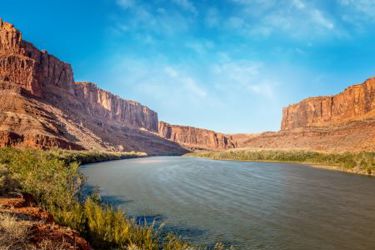Debate Rages Over Dams And Reservoirs As Colorado River Runs Out


As one of the nation’s most critical and iconic water bodies grows increasingly scarce, those who depend on it are trying to figure out how they can grab more for themselves.
“Across the states of the Upper Basin of the Colorado River — Wyoming, Colorado, Utah and New Mexico — new dams are rising and new reservoirs are filling, with more being proposed,” Inside Climate News reported. “In all, the projects have the potential to divert the amount of water Nevada is allocated from the river each year.”
The dwindling Colorado River has become emblematic of the growing problem of water scarcity, which is posing existential challenges to water systems around the country. Competition for Colorado River water has caused major disagreements between state leaders, forced federal intervention, and driven the rise of innovative and expensive drought solutions. Now, as this increasing competition pushes upstream consumers to think about how they can set aside more of the supply before it runs out, it’s raising new debates about how to manage drought-stricken supplies in general.
“Communities across the Colorado River are facing a reckoning,” according to Inside Climate News. “Critics of the proposals for new dams and reservoirs say the time for diverting more water from the river ended decades ago, but supporters argue the projects are essential to help ensure adequate supplies in the upper half of the Colorado River Basin, which currently has little storage capacity for times of extreme drought.”
There is a longstanding argument that eliminating some of the largest dams and reservoirs would benefit the dwindling Colorado River. And that argument is now gaining new momentum, with a powerful group joining the call.
“For years, environmentalists have argued that the Colorado River should be allowed to flow freely across the Utah-Arizona border, saying that letting water pass around Glen Canyon Dam — and draining the giant Lake Powell reservoir — would improve the shrinking river’s health,” per the Los Angeles Times. “Now, as climate change increases the strains on the river, this controversial proposal is receiving support from some surprising new allies: influential farmers in California’s Imperial Valley.”
As consumers of all shapes and sizes continue to debate how best to adapt in the face of a shrinking Colorado River, it’s clear that innovative water management will be central to the future.
To read more about how water managers are evolving in the face of drought, visit Water Online’s Water Scarcity Solutions Center.
